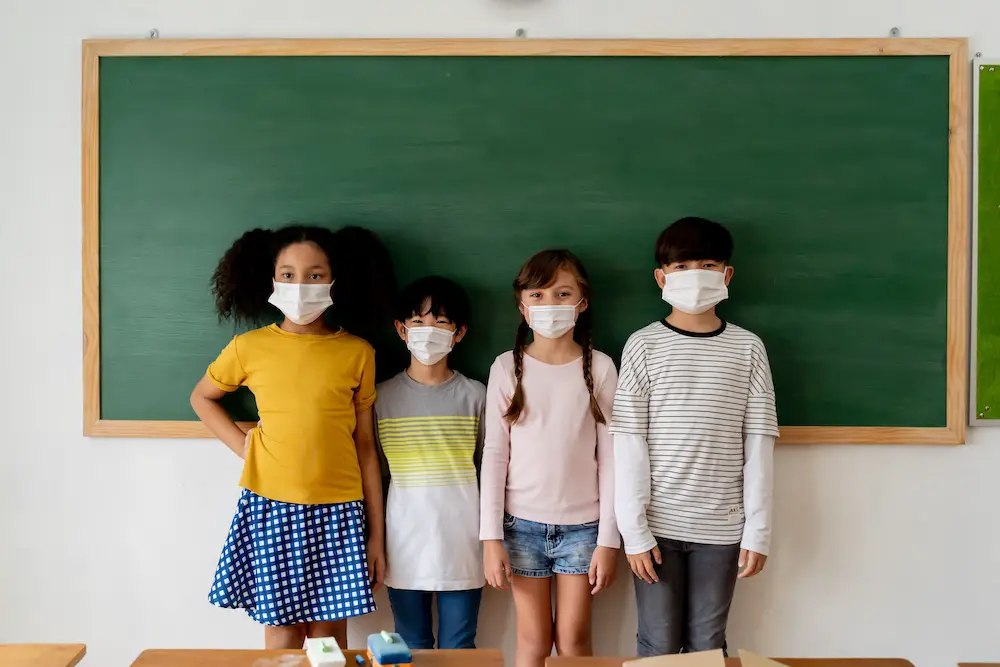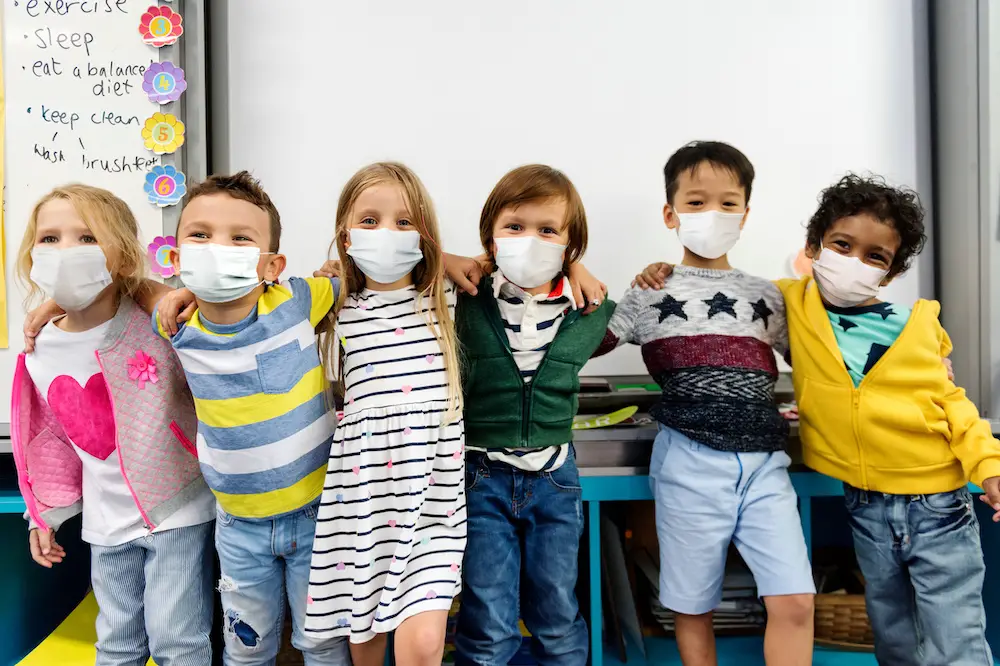Face-to-face school sessions have recommenced amid the continued onslaught of the Coronavirus. Its persistent recurrence into new variants justifies the sustained emphasis on prevention measures, including widespread vaccination, physical distancing, and wearing of masks.
Even with all the facets governing the pandemic, we know little about its wanton effects on the growth and development of children. One of the more obvious effects is speech delay.
Do COVID speech problems arise from wearing face masks in school, at home, and in public?
While studies on this issue are scarce, we’re here to lay the groundwork for probable reasons for the problems.
- How Does a Child Learn to Communicate?
- Do Masks Hinder the Development of Speech and Language Skills?
- COVID Speech Problems Related to Wearing Masks
- Challenges Concerning the Wearing of Masks
- Ways to Communicate With Children While Wearing a Mask
- Boosting Children’s Speech Skills as COVID Continues
- Dealing With Speech Development While Wearing Masks
How Does a Child Learn to Communicate?
Children naturally and rapidly develop communication skills during their first few years. Even from birth, babies express themselves with sounds and facial expressions, and they learn from what they see in the faces surrounding them.
Families encourage speech and language development using interpersonal engagements such as talking, reading, and singing. The more interactions a child gets exposed to, the easier and quicker it is for them to acquire communication skills.
Do Masks Hinder the Development of Speech and Language Skills?
Watching lip and mouth movements and facial expressions is essential for children to learn how to communicate. With opaque masks on, it can be difficult for kids to read your reactions to how they are behaving.
Since babies and toddlers study faces intently, it is normal for parents and guardians to raise concerns about wearing masks all the time.
The debate has been brewing for some time, and some parents think that having a face mask can cause speech delay in their kids.
Nonetheless, no empirical evidence proves that wearing a face mask negatively affects a child’s communication skills.
COVID Speech Problems Related to Wearing Masks
Looking at it closely, parents’ concerns regarding the effects of wearing masks on children’s speech development have a basis. If you have kids of different ages, you probably have firsthand experience in helping them acquire communication skills then and now.
Differences had started becoming apparent as we began wearing masks. Based on parents’ observations, here is a list of speech development problems arising from mask use to prevent the spread of COVID-19:
Unreadable Facial Expressions
As a parent, your child will have problems understanding your statements if you hide your facial expressions under a mask. Since facial expressions are the most obvious social cues, not being able to observe them can lead to misreading emotions and reactions.
Emphasized Use of Upper Facial Expressions
Depending on the type and shape of the face mask worn, our facial expressions can still partially appear. As such, it becomes essential to emphasize facial expressions across the visible areas of our faces.
Since we need to cover our airways for protection against coronavirus transmission, we usually have our upper cheeks, eyes, eyebrows, and forehead exposed.
This arrangement becomes a problem for people who can hardly express emotion through their upper face.

Required Use of Body Language and Personal Space
When an emotion is so strong, it affects our posture and movements.
We use body language to enforce what we have to say, and we open up physical boundaries for people to better understand our emotions. Because of COVID-19, we seldom use our personal space because we need to distance ourselves physically to prevent the spread of the virus.
Alternatively, our use of body language becomes more important because we have to wear masks. If children cannot read our faces, we compensate with body movements, gestures, and hand signals.
Obligatory Increase in Speech Volume
With masks on, lip reading is out of the question. As a result, we will need to speak clearer and louder to convey messages and meaning properly.
Since the volume of our voice has something to do with pitch and tone, we often find ourselves raising or lowering our voices to send a message.
Sometimes, children can mistake a high or low voice pitch for an entirely different meaning.
Necessary Deceleration in Speech
Masks also have a muffling effect on speech. Depending on the material of a face mask worn, uttered words bounce back or get absorbed in the fabric.
It is sometimes better to speak slower with a mask on, especially when you need to say something in a quieter voice.
Promotional Use of Transparent Face Masks
As we continue the debate about the effects of wearing face masks on speech and language learning, many civil groups are formulating temporary solutions.
One of the circulating proposals suggests the manufacturing and distributing of transparent face masks.
Transparent face masks or face shields preserve the importance of facial expressions and emotions while keeping the benefits of personal protection. However, since transparent masks or shields typically comprise plastic materials, they are not as effective for breathability and particle absorption.
Challenges Concerning the Wearing of Masks
The previous section outlines the more obvious issues about wearing face masks around children. However, children with special needs will tackle these challenges differently.
While it can become more difficult to handle for some, it will have a minimal effect on others.
Deaf or Hard-of-Hearing Children
Deaf or hard-of-hearing children who have not yet acquired basic sign language will find it difficult to communicate with people wearing masks. Since they base their reactions on visual cues, facial expressions and mouth movements are integral to developing communication skills.
Also, some activities essential for deaf or hard-of-hearing students are impossible to do with face masks on. These activities include speech therapy, speech training, and lip-reading.
Children With Autism
While there won’t be any long-term effects from wearing masks in classrooms, it can be problematic for children with autism.
Some students on the spectrum already have difficulties combining visual and auditory signals. This difficulty worsens when children cannot see the movements of a teacher’s lips.
In some cases, even the minor change of seeing face masks in school can leave children with autism having trouble adapting to their environment. Nevertheless, an interpersonal learning experience in a classroom with masks is still better than remote virtual learning.
Visually Impaired Children
Compared to other children with special needs or disabilities, visually impaired or blind children are the least affected by the practice of wearing masks.
Since they have heightened senses other than sight, covering facial expressions has minimal to zero effect on them. However, they depend greatly on auditory cues, and the minimal effect on speech comes from the muffled voices of people wearing masks.
Ways to Communicate With Children While Wearing a Mask
You know now the various concerns about helping your children develop speech and language skills while wearing a face mask. These problems are not permanent, and you can always find ways to compensate for the hindrances that wearing face masks pose.
Here are a few tips:
Tip 1: Attention
First and foremost, it is crucial to get a child’s attention before you even start talking or communicating. Doing so ensures that an entire message gets delivered completely from start to finish.
Call out the child’s name calmly and repeatedly, at least until they look at you or face your direction.
Tip 2: Line of Sight or Hearing
Also, it is important to be in the direct line of sight or hearing of a child before you start conveying your message.
Directly face the child and minimize or eliminate all obstructions, noise, and distractions along the child’s field of view or hearing direction.
Tip 3: Clarity
Make your message as clear and calm as a sunny day: speak slowly and loud enough without sounding like you are shouting.
Tip 4: Social Cues
Combine all exploitable social cues. Since you have a mask on, use your eyes, eyebrows, hands, arms, and adjustments in the tone of your voice to diversify the information you wish to convey.
Tip 5: Communication Devices
Be sure that a child has the tools they need for a smooth transition of communication between home and classroom settings. Prescription lenses, hearing aids, books for speech development, and educational toys are just a few examples of essential learning implements.
Tip 6: Confirmation
You may have to repeat words, sentences, or an entire message until you are sure that a child comprehends it. Always look for confirmation and ask a child whether they understood what you are trying to say.
Boosting Children’s Speech Skills as COVID Continues
As a parent, you should know that infants and toddlers get much of their education at home. Since COVID speech problems typically arise from distant learning, virtual classrooms, and mask use, it would be best to take advantage of the home setting.
We do not usually wear masks at home, which means it is the best place to help our children develop speech, language, and social communication skills. All we have to do is dedicate interactive one-on-one, face-to-face sessions with our children so that they can reach their language milestones.
Also, we can take advantage of speech therapy toys and books to help in the learning process. While some kids take longer to learn speech and language skills, others might need professional assistance acquiring them.
Speech delays are very common among young children, but these disorders are easily treatable by language pathologists and speech therapists.
Dealing With Speech Development While Wearing Masks
If we are to resume in-person learning as the pandemic continues, it would be best for safety to be our number one priority.
As we continue to participate in efforts that prevent the spread of the coronavirus disease, face masks are here to stay. Even with masks on, children can continue developing their speech and language skills.
It is up to us, parents, guardians, teachers, and mentors, to ensure progress during our child’s developmental stages.
Whenever we find problems concerning our children’s communication skills, we can always seek advice from our pediatricians. They can help evaluate underlying issues and recommend early intervention programs or therapy sessions.

